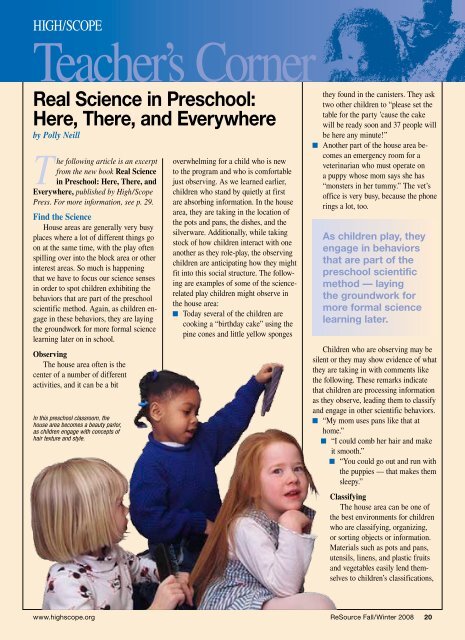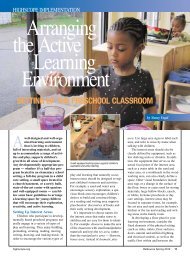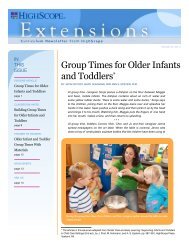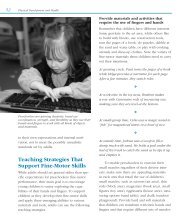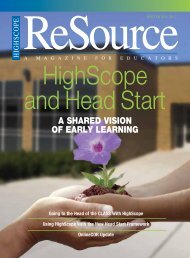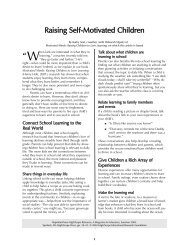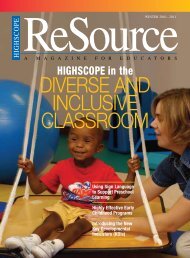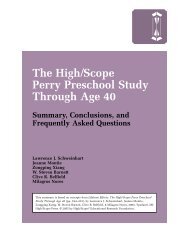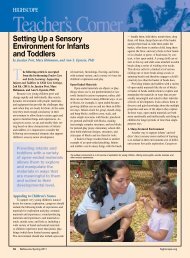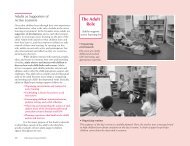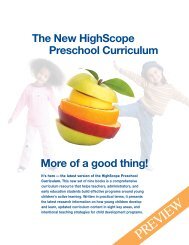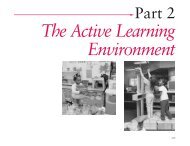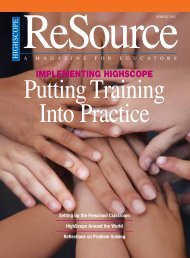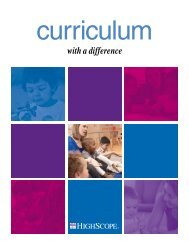Resource - High/scope In The Elementary Classroom
Resource - High/scope In The Elementary Classroom
Resource - High/scope In The Elementary Classroom
Create successful ePaper yourself
Turn your PDF publications into a flip-book with our unique Google optimized e-Paper software.
HigH/SCoPE<br />
Teacher’s Corner<br />
Real Science in Preschool:<br />
Here, <strong>The</strong>re, and Everywhere<br />
by Polly Neill<br />
T<br />
he following article is an excerpt<br />
from the new book Real Science<br />
in Preschool: Here, <strong>The</strong>re, and<br />
Everywhere, published by <strong>High</strong>/Scope<br />
Press. For more information, see p. 29.<br />
Find the Science<br />
House areas are generally very busy<br />
places where a lot of different things go<br />
on at the same time, with the play often<br />
spilling over into the block area or other<br />
interest areas. So much is happening<br />
that we have to focus our science senses<br />
in order to spot children exhibiting the<br />
behaviors that are part of the preschool<br />
scientific method. Again, as children engage<br />
in these behaviors, they are laying<br />
the groundwork for more formal science<br />
learning later on in school.<br />
Observing<br />
<strong>The</strong> house area often is the<br />
center of a number of different<br />
activities, and it can be a bit<br />
<strong>In</strong> this preschool classroom, the<br />
house area becomes a beauty parlor,<br />
as children engage with concepts of<br />
hair texture and style.<br />
overwhelming for a child who is new<br />
to the program and who is comfortable<br />
just observing. As we learned earlier,<br />
children who stand by quietly at first<br />
are absorbing information. in the house<br />
area, they are taking in the location of<br />
the pots and pans, the dishes, and the<br />
silverware. Additionally, while taking<br />
stock of how children interact with one<br />
another as they role-play, the observing<br />
children are anticipating how they might<br />
fit into this social structure. <strong>The</strong> following<br />
are examples of some of the sciencerelated<br />
play children might observe in<br />
the house area:<br />
Today several of the children are<br />
cooking a “birthday cake” using the<br />
pine cones and little yellow sponges<br />
they found in the canisters. <strong>The</strong>y ask<br />
two other children to “please set the<br />
table for the party ’cause the cake<br />
will be ready soon and 37 people will<br />
be here any minute!”<br />
Another part of the house area becomes<br />
an emergency room for a<br />
veterinarian who must operate on<br />
a puppy whose mom says she has<br />
“monsters in her tummy.” <strong>The</strong> vet’s<br />
office is very busy, because the phone<br />
rings a lot, too.<br />
As children play, they<br />
engage in behaviors<br />
that are part of the<br />
preschool scientific<br />
method — laying<br />
the groundwork for<br />
more formal science<br />
learning later.<br />
Children who are observing may be<br />
silent or they may show evidence of what<br />
they are taking in with comments like<br />
the following. <strong>The</strong>se remarks indicate<br />
that children are processing information<br />
as they observe, leading them to classify<br />
and engage in other scientific behaviors.<br />
“My mom uses pans like that at<br />
home.”<br />
“i could comb her hair and make<br />
it smooth.”<br />
“You could go out and run with<br />
the puppies — that makes them<br />
sleepy.”<br />
Classifying<br />
<strong>The</strong> house area can be one of<br />
the best environments for children<br />
who are classifying, organizing,<br />
or sorting objects or information.<br />
Materials such as pots and pans,<br />
utensils, linens, and plastic fruits<br />
and vegetables easily lend themselves<br />
to children’s classifications,<br />
www.high<strong>scope</strong>.org ReSource Fall/Winter 2008 20


